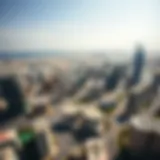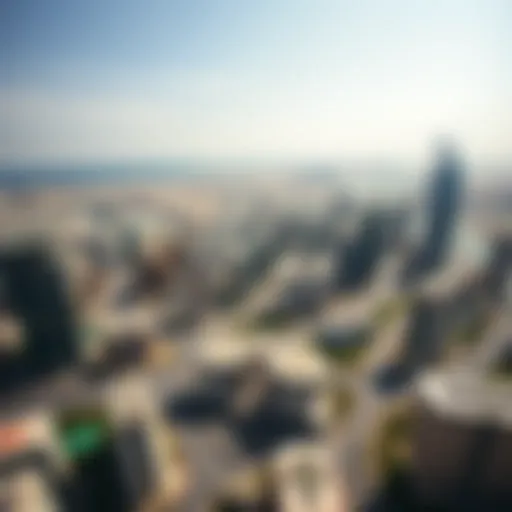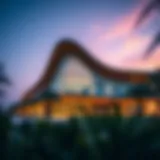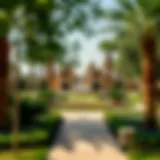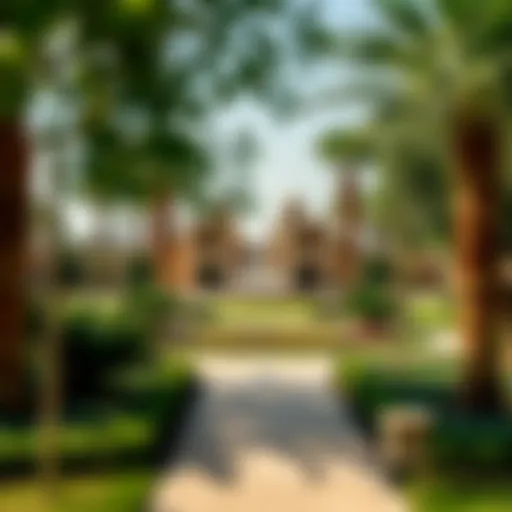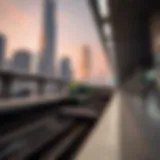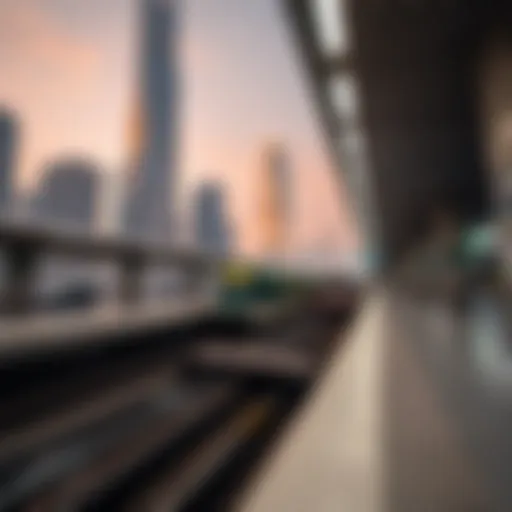Exploring the Dubai Metro and Tram System
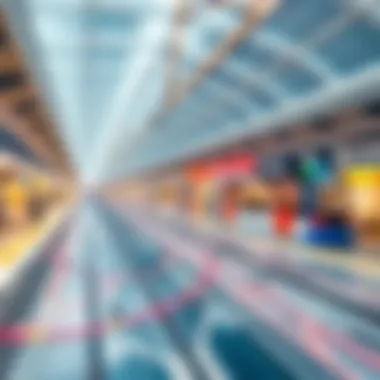

Intro
The urban landscape of Dubai has transformed dramatically over the past few decades, establishing itself as a global hub. Beneath its glistening skyline lies an efficient transport system that not only eases the daily commute of residents and tourists but also greatly influences the real estate market. The Dubai Metro and Tram system represent pivotal components of this infrastructure. Understanding these transport networks is vital for investors, property buyers, and analysts looking to navigate the city's real estate terrain.
This guide aims to delve into the intricacies of the Dubai Metro and Tram system. It will assess their operational structures, evaluate the current market trends, and explore how these transportation modes interact with property values in the bustling urban framework.
While public transport systems often go unnoticed, they are the lifeblood of urban mobility. As such, they have a profound impact on urban planning, real estate investments, and long-term property values.
The forthcoming sections will engage readers with detailed route analyses, current user statistics, and insights into future expansion projects. By the end of this exploration, one should possess a clearer view of how the Dubai Metro and Tram systems shape not only the city's accessibility but also influence investment opportunities in real estate.
Prelims to Dubai's Public Transportation Network
Navigating through a bustling metropolis like Dubai demands a sophisticated public transportation system. In a city famous for its soaring skyscrapers and sprawling urban landscape, understanding the public transport options available becomes not just beneficial but essential.
Overview of Travel Options in Dubai
Dubai presents a variety of travel options, with its public transportation network being one of the most efficient in the region. The key modes of transport include:
- Dubai Metro: A driverless, fully automated metro system that spans multiple lines with over 50 stations.
- Dubai Tram: Connecting areas like Dubai Marina to Jumeirah Lake Towers, the tram is both modern and user-friendly.
- Buses: A vast fleet of buses covers extensive routes, ensuring connection to areas not served by the Metro.
- Water Transport: From traditional abras to modern ferries, water taxis make for a picturesque commute along Dubai Creek and the coastline.
For businesses, potential homebuyers, and real estate investors, knowing these options provides insights into accessibility and convenience, which are key factors in property valuation.
Importance of Efficient Transport Systems
Efficient transportation is a lifeline for any growing city. The role of public transport in Dubai cannot be understated. Here are a few points to ponder:
- Accessibility: Easy access to various areas encourages tourism and sustains local businesses.
- Time Efficiency: A well-structured system minimizes travel time, allowing residents and visitors to maximize their experience in the city.
- Reduced Traffic Congestion: By offering reliable alternatives to private vehicles, public transport helps lessen road congestion, significantly improving air quality.
"A city’s transport system is a reflection of its ambition. In Dubai, this ambition is sky-high.”
In closing, the public transportation network in Dubai is not merely a convenience; it’s a cornerstone of urban growth and development. With a keen understanding of these systems, one can appreciate their impact on property values and the wider real estate market. Investors should realize that efficient transit can drive demand in property markets, making this an insightful area of focus for those looking to engage in Dubai’s real estate landscape.
The Dubai Metro: An Overview
The Dubai Metro represents a crucial element of the city's public transportation framework, serving both residents and tourists. Its significance lies not just in the convenience it offers but in how it has reshaped urban mobility in the rapidly developing landscape of Dubai. The Metro is a symbol of modernization, highlighting the emirate's commitment to efficient transit solutions, which plays an important role as the urban environment expands and evolves.
By connecting major landmarks, shopping districts, and residential areas, the Metro acts as an arterial system that alleviates road congestion and reduces travel times. This is particularly vital in a city where the population is continuously growing, and the demand for effective transport is escalating alongside it. To put it plainly, the Metro isn't just about getting from point A to B; it's about linking communities and fostering economic growth.
History and Development of the Metro
The inception of the Dubai Metro can be traced back to the early 2000s, a time when the city's swift expansion sparked visions for an advanced transit system. The project officially started in 2006, and the first line, the Red Line, became operational in 2009. This ambitious undertaking was not merely about technology and infrastructure; it was about a vision to enhance public transport in a city that was rapidly transforming.
The system took inspiration from other major cities, bringing cutting-edge technology and a commitment to sustainability. The construction process faced its own set of challenges—complex engineering tasks and a rapid pace of development defined the early years. However, the final product was a testament to Dubai's ability to turn bold dreams into reality, culminating in a network that has grown to include extensive rail lines and modern stations.
Metro Line Details and Routes
The Dubai Metro comprises multiple lines designed to cater to a diverse demographic. Each line presents a unique alignment,
The Metro's Operational Features
The operational features of the Dubai Metro form a critical backbone in its design, delivering an efficient and user-friendly way to traverse the city. Understanding these features is essential for investors, property buyers, and market analysts because the functionality of the metro directly affects commuter preferences, property desirability, and overall urban growth. The metro system is not just a mode of transport; it plays a pivotal role in shaping the daily lives of Dubai’s residents and visitors, as well as influencing economic trends!


Ticketing and Pricing Structure
The ticketing and pricing structure of the Dubai Metro is designed to be accessible, encouraging frequent use by a diverse population. It operates on a smart card system called the NOL card, which simplifies the process of purchasing and using a ticket. Users can choose between various types of NOL cards, including:
- Red Ticket: Ideal for tourists, offering a limited number of trips.
- Silver Card: A popular choice for residents, providing the benefits of pay-as-you-go.
- Gold Card: Allows for a more luxurious travel experience in Gold Class cabins.
Pricing is calculated based on the distance traveled. It operates on a zone system, meaning you pay more for longer trips. The cost ranges from a few dirhams (around 2 AED) for shorter trips to around 8 AED for the longest journeys. This pricing model not only enhances affordability for regular commuters but also presents a lucrative opportunity for stakeholders analyzing transport-related investment potential.
Safety Measures and Quality Standards
Safety is paramount in the operation of the Dubai Metro, which boasts an excellent safety record. The Dubai Roads and Transport Authority (RTA) enforces stringent safety measures and quality standards.
Key features include:
- Advanced Technology: Monitoring systems and real-time alerts are equipped on trains, ensuring a proactive response to potential hazards.
- Trained Personnel: Metro staff undergo extensive safety training and drills to manage various scenarios effectively.
- Emergency Protocols: Solid procedures are in place for emergency situations, ensuring passenger safety and confidence in the system.
This commitment to safety encourages more residents and tourists to rely on the metro as a preferred travel option, making it a fundamental component of urban mobility with implications for property valuations near metro stations.
Integration with Other Transport Modes
An integral aspect of the Dubai Metro's operational framework is its seamless integration with other transport modes, notably the Dubai Tram, buses, and taxis. This integration fosters an efficient transport ecosystem, allowing passengers to transfer effortlessly between modes. This accessibility enhances the overall value of property located near transport hubs.
Benefits include:
- Strategic Transfer Points: Metro stations link directly to tram stations, bus terminals, and taxi stands, reducing the friction often felt in public transport transfers.
- Unified Payment System: The NOL card allows passengers to use one single card across all modes of transportation, simplifying the travel experience.
- Enhanced Connectivity: Areas that may shy away from heavy metro reliance can benefit from the multi-modal connections that cover wider urban spaces.
This interconnected system exemplifies the importance of transport planning in urban development and real estate investment strategies as it creates neighborhoods where public transport is easily accessible, thus boosting property values.
"Public transport innovations don't just lift cities but also boost the real estate market where they thrive!"
The operational features outlined above offer remarkable insights into the strategic interplays of health, safety, and transit efficiency pivotal to Dubai’s broader urban narrative. Stakeholders who grasp these dynamics are better equipped to make informed decisions in the rapidly evolving real estate landscape.
The Dubai Tram: A Complementary System
Navigating through the hustle and bustle of Dubai, the tram system emerges as not just an afterthought but a vital player in the city’s transport landscape. Designed to complement the expansive Dubai Metro, the tram offers reliable transportation that connects key areas, particularly the bustling waterfront neighborhoods. This seamless integration ensures that both residents and visitors can easily access important locations, making it an invaluable aspect of Dubai’s public transportation network.
Preamble to the Tram System
The Dubai Tram officially commenced operations in November 2014, marking a significant advancement in urban transit for the emirate. Unlike the towering metro that mostly serves the core urban areas, the tram weaves through the glamorous and lively districts of Dubai Marina and Jumeirah Beach Residence. Spanning about 14 kilometers, the tramway comprises 11 stations, with links strategically placed to facilitate smooth transfers with the metro system, thereby enhancing the overall connectivity in Dubai.
There’s more to the tram system than just the tracks and stations. It plays a crucial role in reducing road congestion, especially in high-traffic zones. With state-of-the-art trams that can hold a significant number of passengers, it’s no wonder that locals and tourists often prefer this mode of transport. Moreover, the air-conditioned comfort of the trams makes for a cooler ride as temperatures soar in hot months.
Route Analysis of the Tram Network
When looking at the tram route, it’s easy to notice the well-thought-out coverage of key areas. The tram system runs from Al Sufouh to the luxurious Jumeirah Beach, providing convenient access to several hotels, shopping centers, beaches, and entertainment venues. Here are some noteworthy insights into the network:
- Station Highlights: Key stops include the Dubai Marina Mall and Dubai Marina station, which are frequent destinations for both shoppers and leisure seekers.
- Integration with Metro Lines: Passengers can switch seamlessly to the Dubai Metro at the tram stop near the Mall of the Emirates, making transfers easy and efficient.
- Scenic Views: One of the tram’s distinctive features is the experience it offers. As it glides through the Marina area, passengers are treated to stunning views of skyscrapers and the glistening waterfront, turning a routine commute into a visual feast.
"The tram system serves not only as transportation but also as a means to experience the aesthetic pulse of Dubai."
Moreover, the economical pricing structure combined with ease of use enhances the tram’s appeal. Users can purchase Nol cards that allow them to travel across both tram and metro systems with ease, encouraging more residents to utilize these resources for daily commuting.
With plans to expand, the tram is set to evolve even further, addressing the demands of a growing population while providing efficient, eco-friendly public transport solutions. Ultimately, the interconnectivity achieved through the tram and metro will likely continue to shape the future of urban mobility in Dubai, proving its significance in the broader public transit system.


User Statistics and Passenger Insights
Understanding the user statistics and passenger insights of the Dubai Metro and Tram system plays a crucial role in assessing the impact and effectiveness of public transportation in this bustling city. The numbers tell a story: they reveal not just the scale of usage but also highlight trends that can influence future investments and urban planning decisions. Dive into these aspects, and one may uncover valuable information for investors and property buyers looking to capitalize on the shifting dynamics of the real estate market.
Demographics of Metro Users
The demographic landscape of metro users in Dubai is rich and varied. Targeting a mix of residents and tourists, the metro system caters to individuals from numerous backgrounds, spanning different ages, nationalities, and socio-economic statuses. According to recent studies, around 60% of metro users are expatriates, which mirrors Dubai's status as a melting pot of cultures.
Many users rely on public transport for commuting to work, with younger professionals often forming the bulk of daily passengers. On the other hand, tourists frequently opt for the metro to explore the city, especially areas like Dubai Mall and Burj Khalifa, which are conveniently connected by the rail network. Furthermore, the age distribution shows that
- 23% of users are between 25-35 years old,
- 32% fall in the 36-50 age group,
- and the remaining represent other ages.
This information is essential as it informs potential investors about the diverse client base that public transport systems support. An upsurge in younger professionals signals a demand for residential properties near metro stations, while increasing tourist numbers may encourage commercial developments catering to visitors.
Passenger Growth Trends
Passenger growth trends in Dubai's public transport systems present a compelling case study in urban mobility. The metro has seen an incredible increase in ridership since its inception, with trends indicating a steady rise year on year. For instance, the metro recorded over 200 million users annually, with numbers continuing to escalate due to the local government's strategic initiatives to promote public transport.
Several factors contribute to these upward trends:
- Infrastructure Development: As new metro lines and tram routes are being introduced, areas that previously had limited access to public transportation become connected, driving more passengers to use the services.
- Incentivizing Public Transport Use: Initiatives like discounted fares and integrated ticketing systems encourage citizens to rely more on public transportation.
- Sustainability Goals: The focus on reducing carbon footprints and emissions draws environmentally conscious riders—making public transport a more attractive option.
These trends not only boost daily ridership but also signal growing confidence in public transport systems among both residents and tourists. Investors in the real estate space must pay attention to these patterns—they can indicate potential boons for property values in areas that are effectively serviced by metro and tram networks.
In summary, the user statistics and passenger insights provide critical data that showcases the importance of the Dubai Metro and Tram systems. Understanding these demographics and trends enhances the narrative for potential investors and stakeholders, providing a foundation for informed decision-making in real estate investments pertinent to urban transport systems.
For more information on user trends, you can refer to the Dubai Roads and Transport Authority for statistical reports and insights into the public transportation landscape in Dubai.
Impact on Real Estate Market
The relationship between public transportation and real estate values cannot be underestimated, especially in a dynamic city like Dubai. A robust metro and tram system not only promotes urban connectivity but also significantly impacts local property markets. As investors and property buyers increasingly look for opportunities with high growth potential, understanding how transport infrastructure affects real estate is paramount.
Correlation Between Transport and Property Values
Multiple studies have shown that properties located near transit stations tend to boast higher property values. For instance, homes within a close radius of Dubai’s metro stations often see an uptick in demand, primarily due to the convenience they offer. People are willing to pay a premium for easy access to public transport, which reduces commuting time and eases the daily grind.
Factors contributing to this correlation include:
- Accessibility: Properties close to metro lines benefit from higher foot traffic and accessibility, making them attractive to potential buyers and renters.
- Urban Development: Areas surrounding metro stations are often slated for development, leading to improved amenities and infrastructure, like shopping centers and recreational areas.
- Market Trends: As more people adapt to using public transport, particularly expats, there’s a tangible increase in interest in centralized living, further boosting property values.
Recent statistics illustrate how the introduction of new metro lines, like the extension of the Red Line, has dynamically shifted property prices. In neighborhoods like Dubai Marina and Jumeirah Beach Residence, prices have reportedly risen as transport connectivity enhances living standards.
Neighborhoods Benefiting from Proximity to Transport
When looking at specific neighborhoods in Dubai, a few stand out for their advantageous locations relative to the metro and tram system.
- Dubai Marina: A bustling area with a variety of apartments and luxury villas, boast proximity to the metro. This hub attracts both local and international buyers looking for a lively lifestyle.
- Downtown Dubai: Home to iconic landmarks like the Burj Khalifa, its accessibility via tram encourages investment, as convenience remains a greater aspiration for many.
- Business Bay: This area is rapidly developing and is near several metro stations. Its growth prospects appeal greatly to investors, signalling a hotspot for real estate ventures.
Investors and homebuyers should pay attention to where the new metro lines will be constructed, as this can forecast rising values and interest. Areas set to experience transportation upgrades typically see property prices soar in anticipation.
"Transport connectivity is not merely an advantage in Dubai; it is a necessity that shapes the urban landscape and investment landscape alike."


In summary, the nexus between the metro and property values is multifaceted. As Dubai continues to evolve its transportation landscape, understanding these correlations will be indispensable for savvy investors seeking to maximize their returns in the real estate market.
Future Developments and Expansions
The exploration of future developments within the Dubai Metro and Tram system holds vital importance as it reflects the city’s broad ambition of fostering sustainable urban environments and improving public transportation. As demand grows and the population expands, the integration of new projects becomes essential for maintaining efficiency and accessibility. Looking ahead, the potential expansions will not only serve commuters better but also provide numerous benefits that can ripple through the property market and urban design.
Upcoming Metro Projects
Dubai is not one to rest on its laurels, as illustrated by the scheduled projects aimed at scaling the metro network. A detailed analysis reveals plans for two new extensions: one extending the Red Line towards the Expo 2020 site with added stops that will enhance connectivity to tourist hotspots; and the second expanding the Green Line to reach the densely populated areas of Al Quoz. Such developments are set to enhance convenience for residents and tourists alike.
"The goal is to not just add more stations, but to create interconnected communities that rely less on private vehicles, contributing to a cleaner city."
— Urban Development Expert
These expansions are significant. They promise to ease congestion and optimize transit times, making travel smoother for all. Moreover, construction plans are also underway for an Australian-designed tram route that will link key business districts, adding to the integrated transport network.
Potential Impact on Urban Development
The interplay of transportation developments and urban growth is crucial. When new metro lines are laid or tram stops are established, they invariably reshape local ecosystems. Property values tend to rise near these new nodes because they provide easy access to transportation, making them attractive to both investors and homebuyers.
- Elevated Property Values: Proximity to transit stations often leads to increased property values. Homes and commercial spaces within a short walking distance from metro stations see higher demand.
- Urban Density and Mixed-Use Developments: With the planned expansions, developers could promote denser projects. Mixed-use developments combining residential, retail, and office spaces become more viable near transportation hubs.
- Environmental Benefits: Enhanced public transport systems encourage residents to opt for public transit over personal vehicles, contributing to lower emissions and reduced road congestion.
In summary, as the Dubai Metro and Tram system evolves, the anticipated expansions will likely usher in transformative changes, potentially increasing property values and fostering sustainable urban living. Investors, agents, buyers, and analysts should keenly observe these developments to leverage future opportunities.
For further insights into the world of urban transit developments, one can explore resources such as Wikipedia, Britannica, or community discussions on Reddit for real-time local insights.
Challenges and Considerations
In an ever-evolving metropolis like Dubai, the integration of an efficient public transport system is not merely a convenience but a necessity. The challenges and considerations surrounding the Dubai Metro and Tram system play a pivotal role in shaping urban advancements and ensuring the city meets the demands of its growing population. Addressing these challenges can boost the effectiveness of travel services and provide insights into future investments in the sector.
Infrastructure Challenges
One of the most significant hurdles for Dubai’s public transport system remains its infrastructure. As the city extends its reach, the demand for robust infrastructure grows exponentially. Several factors contribute to these challenges:
- Aging Infrastructure: Portions of the existing metro tracks require constant upgrades to cope with increased passenger loads. Delay in addressing this can lead to overcrowded stations and safety concerns.
- Urban Congestion: Dubai's rapid urban development has resulted in congested streets, which can complicate future expansions of the tram and metro networks. Resistance from existing urban layouts can hinder project timelines and escalate costs.
- Financial Constraints: Securing funding for infrastructure projects can be tenuous. Investors must balance potential returns with the significant upfront costs of construction and maintenance.
"Efficient infrastructure directly correlates with the quality of public transport. Poor infrastructure does not just affect travel comfort; it influences property values and urban livability."
Environmental and Urban Planning Issues
The environmental impact and urban planning considerations are also paramount in the discussion of public transport systems. The Dubai Metro and Tram must align with wider city planning initiatives focusing on sustainability. Key points include:
- Environmental Sustainability: Developing an eco-friendly public transportation network is essential. The tram's electric-powered system aims to reduce carbon emissions, but more can always be done. Investing in renewable energy sources and sustainable materials can augment these efforts.
- Integration with Urban Development: Planning for the future of Dubai involves ensuring the Metro and Tram lines connect efficiently with new buildings, parks, and residential areas. Failure to do so may lead to a fragmented transport network that does not meet the city’s needs.
- Community Impact: Projects must consider community input and address how constructions affect local residents. Balancing urban development with community well-being is a complex dance requiring extensive planning and negotiation.
Finale: The Significance of Public Transport in Dubai
In a city as dynamic as Dubai, where skyscrapers scrape the sky and innovation thrives, public transport isn't just a convenience; it's a vital cog in the wheel of urban life. The Dubai Metro and Tram system plays a pivotal role in ensuring that the daily hustle and bustle flows smoothly. Investing in a property near these transportation hubs not only enhances accessibility but also represents a savvy economic decision. As commuting challenges loom over the future of urban development, effective transport systems like the Metro and Tram become indispensable.
Summary of Key Insights
Navigating through the details of Dubai's public transport conveys a range of insights that investors should consider:
- Connectivity and Accessibility: The Metro and Tram network covers significant areas of the city, linking key attractions, business districts, and residential zones. This connectivity can lead to increased footfall and consequently raise the valuation of nearby real estate.
- Increased Property Demand: Areas adjacent to transport lines often see an uptick in property interest, as both residents and businesses value easy transport access. This creates a ripple effect that enhances the overall market value.
- Urban Sustainability: By promoting the use of public transport, Dubai aims to ease congestion and reduce environmental footprints. Investors should appreciate the long-term benefits of a more sustainable urban environment, as it can drive up property values in areas with strong public transport links.
"Effective public transport systems are the backbone of any thriving city, impacting not just connectivity, but also property markets and urban planning."
Final Thoughts for Investors
As investors gaze into the future of Dubai, it's clear that the public transport system is more than just a set of trains and trams. It symbolizes growth, opportunity, and connectivity.
- Long-Term Vision: Investors should keep an eye on expansion plans of the Metro and Tram systems. Growth in these areas can translate into profitable opportunities.
- Market Analysis: Understanding passenger trends and user demographics can help in predicting which neighborhoods may experience property appreciation.
- Challenges Ahead: While the current infrastructure supports urban movement, it’s crucial to stay informed about potential challenges, like infrastructure wear or the environmental factors that could affect transport efficiency.
